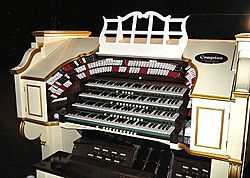John Compton (organ builder) facts for kids
John Compton (1876–1957), born in Newton Burgoland, Leicestershire was a pipe organ builder. His business based in Nottingham and London flourished between 1902 and 1965.
Life
John Compton was educated at King Edward's School, Birmingham and then studied as an apprentice with Halmshaw & Sons in Birmingham. In 1898 he joined Brindley and Foster in Sheffield. Then he joined Charles Lloyd in Nottingham.
He set up the business Musson & Compton in 1902 in Nottingham with James Frederick Musson. The partnership dissolved in 1904. In 1919, the business moved to workshops at Turnham Green Terrace, Chiswick, London, which had been vacated by August Gern. He occupied a new factory at Chase Road, Park Royal, North Acton, London in 1930.
Compton worked primarily on electric-action pipe organs and electronic organs. Compton's first electronic instrument was the Melotone (a solo voice added to theatre organs); next came the Theatrone. The Electrone, an electrostatic tonewheel instrument introduced in 1938, evolved out of research by Leslie Bourn, an association begun in the 1920s. Throughout his organ-building career, John Compton was assisted by the very capable and inventive James Isaac Taylor, who spent his entire working life with the Compton firm prior to his death in 1958. John Compton also befriended a wealthy industrialist by the name of Albert Henry Midgley; one of the founders of C A Vandervell, which was later to become CAV-Lucas Ltd; a major supplier of electrical equipment to the motor industry. Midgley was one of the most prolific inventors of his age, with over 900 inventions to his name and following a rift with C A V-Lucas,he was appointed Technical Director of the Compton firm soon after, in 1925. Midgley's genius in electrical engineering and mass-production techniques, helped the Compton firm to achieve an extraordinary level of productivity. The company were awarded many original patents in things ranging from simple organ mechanisms to the most complex, state of the art electronic and electrical inventions. Many of those patents show that Midgley was cited as the inventor.
On 13 June 1940, during World War II, Compton was arrested while holidaying on the island of Capri, in Italy. He was interned as an enemy alien but spent much of his time restoring pipe organs, before being permitted to return to England.
Compton died in 1957, and the business continued under the direction of his right-hand man, James I Taylor. Taylor died the year after in 1958, and the business was wound up around 1965. The pipe organ department was sold to Rushworth and Dreaper; the electronic department became Makin Organs.
Compton organs
Compton cinema organs, built by the John Compton Organ Company of Acton, were the most prevalent of theatre organs in the UK; 261 were installed in cinemas and theatres in the British Isles. Comptons made many fine church and concert organs as well. Their cinema organs employed the latest technology and engineering and many are still in existence today. One of the most notable is the large 5 manual example at the Odeon Cinema Leicester Square in central London.
List of new organs
- All Souls' Church, Radford 1903
- Emmanuel Church, Nottingham 1903
- United Methodist Free Church, Stapleford 1903
- Church of St. Mary Magdalene, Hucknall 1903
- Emmanuel Church, New Park St, Leicester 1905
- St Wilfrid's Church, Cantley 1905
- Selby Abbey 1906
- St. Peter's School Chapel, York 1907
- Launceston Wesleyan Church 1909
- Holdenhurst Road Methodist Church, Bournemouth 1909
- Westbourne Wesleyan Church, Bournemouth 1910
- Shakespeare Street Wesleyan Reform Chapel, Nottingham 1914
- Stowmarket Parish Church, 1922
- St Swithun's Church, Cheswardine, Shropshire, 1922 memorial for those killed in the 1914-1918 war
- Shepherd's Bush Pavilion 1923
- Bournemouth Pavilion Theatre 1929
- Elite Picture Theatre, Nottingham 1930
- Chapel Cranleigh School Surrey 1930. Eight Ranks, Three manuals. Lasted until 1978. Verifiable on NPOR site
- Church of St Osmund, Parkstone 1931
- Downside Abbey 1931
- St. Mary Magdelene's Church, Paddington 1932
- Church of St Edmund the King and Martyr, Lombard Street, London 1932
- BBC Theatre Organ Broadcasting House, London 1932
- Broadway Theatre, Catford, 1932:- (contemporaneously, a music hall)
- Plaza Cinema, Stockport 1932
- St Luke's Church, Chelsea 1932
- Odeon Cinema, Weston-super-Mare 1935
- St. Benedict's Priory, Ealing 1935
- East Church of St Nicholas, Aberdeen 1936
- Southampton Guildhall 1936
- Regent Street Cinema, London 1936
- St. George's Hall, London, second BBC Theatre Organ (1936)
- Maida Vale Studios, third BBC Theatre Organ, 1936.
- Odeon Cinema, Leicester Square 1937
- Emmanuel United Reformed Church, Worthing 1937 (formerly St Columba's Presbyterian Church)
- Wolverhampton Civic Hall 1938
- Methodist Mission, Great Yarmouth 1938
- St John's Cathedral, Salford 1938
- Church House, Westminster 1939
- Christchurch Priory 1951
- St Eugene's Cathedral, Derry 1956
- St Bride's Church London 1957
- St George's Cathedral, Southwark 1958
- St Alban Golders Green, London
- Westover (now ABC) Cinema, Bournemouth c.1937
- Astoria Cinema, Pokesdown c.1930s
(the last two organs are unconfirmed, but their existence is attested to by local documentary sources; the Westover instrument is now in private hands at Ryde on the Isle of Wight; the Astoria instrument no longer exist)
- Southern Grammar School for Boys, Portsmouth c. 1957
- Portsmouth Guildhall 1959
- St.Alban's Holborn 1961
Rebuilds and restorations
- Holy Trinity Church, Hull 1938
- Holy Trinity Church, Exmouth 1953
- Christ Church Pennington, Leigh - 1953
- St Catherine, Bearwood, Wokingham, Berkshire. 1952 (NPOR A00449)
- Tower Hill Methodist Church, Hessle 2001 (Formerly at Oxted United Reformed Church, Surrey)
Other sources
- Ivor Buckingham, The Compton List: dedicated to the John Compton Organ Company and its products - includes details on Theatrones and Electrones
- Penistone Cinema Organ Trust: Compton Organ


